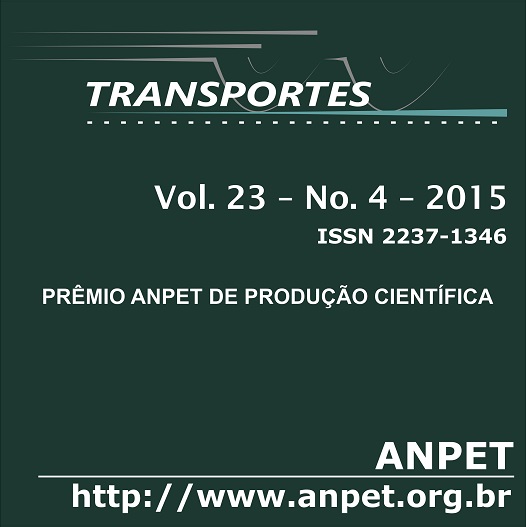...
DOI:
https://doi.org/10.14295/transportes.v23i4.928Keywords:
bicycle facility planning, use of bicycle, discrete choice models, and infrastructure cycling.Abstract
The main aim of this work is to propose a procedure to identify and quantify the factors that influence the use of bicycles and to present how these factors can be used to evaluate and plan the deployment of segregated bike lanes and/or cyclelanes in an urban area. For attaining the aim, a method was developed and consisted firstly in to obtain socioeconomic data and travel data in places equipped with segregated bike lanes and/or cyclelanes available to the population and with counts of cyclists before and after the implementation of cycling infrastructure. Then, an experiment was conducted which consisted of characterization of the socioeconomic data and urban trips and cycling infrastructure from which a discrete choice model was estimated that allowed the identification of factors that influence the use of bicycles in a Santos Metropolitan Area and was used to quantify the cycling demand on predetermined points. The main aim of this work was obtained by the construction of scenarios before and after the implementation of cycling infrastructure and the comparison between counts of cyclists in a Santos Metropolitan Area and the estimation of cycling demand in these points using discrete choice model.Downloads
References
An, M.; Chen, M. (2007). Estimating Nonmotorized Travel Demand. Transportation Research Record: Journal of the Transportation Board, nº. 2002. Washington, DC.
DOI: 10.3141/2002-03.
IBGE (2007). Pesquisa Anual da Indústria da Con-strução. IBGE - Instituto Brasileiro de Geografia e Es-tatística, v. 17, p. 1 - 84. Rio de Janeiro-RJ, Brasil. ISSN 0104-3412.
Katz, R. (1995). Modelling Bicycle Demand as a Main-stream Transportation Planning Function. Transportation Research Board 1502, p. 22-28. Washington, D.C.
Kawamoto, E.; Setti, J. R. (1992). Procedure for the Cali-bration of a Semicompensatory Mode Choice Model. Transportation Research Record: Journal of the Transpor-tation Board, n. 1357. Washington, DC.
PCM (2006). Estudos técnicos, levantamentos, diagnósti-co e diretrizes para elaboração do Plano Cicloviário Metropolitano (PCM) da Região Metropolitana da Bai-xada Santista, 349f. Santos-SP, Brasil.
Porter, C.; Suhrbier, J.; Schwartz, W. L. (1999). Forecasting bicycle and pedestrian travel: State of the practice and research needs. Transportation Research Record: Journal of the Transportation Board, nº. 1674. DOI: 10.3141/1674-13.
Rietveld, P.; Daniel, V. (2004). Determinants of bicycle use: do municipal policies matter? Transportation Re-search Part A 38, p. 353-373. DOI: 10.1016/j.tra.2004.05.003.
Rietveld, P.; Koetse, M. (2003). Crime and offences in transport. Em: Jourquin, B.; e Polak, J. (eds.), Progress in Transportation Research – 2003, De Boeck, Antuérpia, Bélgica, p. 123-142.
Ryley, T. (2006). Estimating cycling demand for the jour-ney to work or study in West Edinburgh, Scotland. Trans-portation Research Record: Journal of the Transportation Board, n. 1982. DOI: 10.3141/1982-24.
STM (2007). Relatório Técnico – Pesquisa Origem-Destino 2007: Região Metropolitana da Baixada Santista, 110f. Secretaria dos Transportes Metropolitanos do Es-tado de São Paulo – STM/SP. São Paulo-SP, Brasil.
Zhang, D.; Magalhães, D. J. A. V.; Wang, X. (2014). Priori-tizing bicycle paths in Belo Horizonte City, Brazil: Analy-sis based on user preferences and willingness considering individual heterogeneity. Transportation Research Part A 67, p. 268-278. DOI: 10.1016/j.tra.2014.07.010.
Downloads
Published
How to Cite
Issue
Section
License
Authors who submit papers for publication by TRANSPORTES agree to the following terms:
- The authors retain the copyright and grant Transportes the right of first publication of the manuscript, without any financial charge, and waive any other remuneration for its publication by ANPET.
- Upon publication by Transportes, the manuscript is automatically licensed under the Creative Commons License CC BY 4.0 license. This license permits the work to be shared with proper attribution to the authors and its original publication in this journal.
- Authors are authorized to enter into additional separate contracts for the non-exclusive distribution of the version of the manuscript published in this journal (e.g., publishing in an institutional repository or as a book chapter), with recognition of the initial publication in this journal, provided that such a contract does not imply an endorsement of the content of the manuscript or the new medium by ANPET.
- Authors are permitted and encouraged to publish and distribute their work online (e.g., in institutional repositories or on their personal websites) after the editorial process is complete. As Transportes provides open access to all published issues, authors are encouraged to use links to the DOI of their article in these cases.
- Authors guarantee that they have obtained the necessary authorization from their employers for the transfer of rights under this agreement, if these employers hold any copyright over the manuscript. Additionally, authors assume all responsibility for any copyright infringements by these employers, releasing ANPET and Transportes from any responsibility in this regard.
- Authors assume full responsibility for the content of the manuscript, including the necessary and appropriate authorizations for the disclosure of collected data and obtained results, releasing ANPET and Transportes from any responsibility in this regard.









